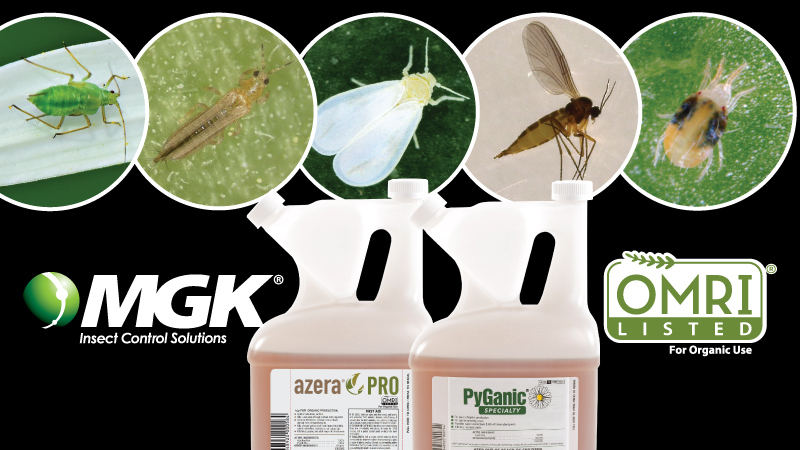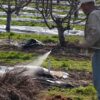Insect pests in greenhouses are a problem that all growers experience to some degree during the growing season. These issues range from small amounts of insects to large, seemingly uncontrollable infestations. Besides the physical damage that they can do to a crop, many insects can also transmit diseases, causing plants to wilt and die, creating profit loses for the grower.
There are many products on the market today to combat most insect pressures, however, many of these products contain conventional chemistry that can be harmful to the environment, applicators, and employees, as well as other animals that may come in to contact with them. For this reason, many growers are making a switch and adding OMRI Listed botanically-derived insecticides to their rotations in order to reduce the impact on the environment and create a safer working environment for themselves and their employees.
MGK is a leading manufacturer of botanically derived plant protection products. Through Mycorrhizal Applications’ distributors, growers can purchase two of these OMRI Listed professional insect protection products: Pyganic Specialty and Azera Pro. Pyganic Specialty has pyrethrins as its active ingredient, which is a broad spectrum contact insecticide. Azera Pro is a combo product of pyrethrins mixed with azadirachtin. Again, the pyrethrins provide broad spectrum contact control affecting the insects’ nervous system, while the azadirachtin on the IRAC website is classified as unknown or non-specific mode of action, but also affects many different species. An insecticide can be classified this way if the target site is not well described or well known, or if the compound acts non-specifically on multiple target sites. We do know that azadirachtin often has an anti-feedant effect and/or an IGR effect and has some systemic activity. Insects can stop feeding and/or have reduced reproduction and molting defects. These products are both listed for over 200 crops and provide control for a wide variety of common greenhouse pests.
The Top-5 most common insect pests that are found in greenhouses are: Aphids, Thrips, Whiteflies, Fungus Gnats, and Mites, and this article will outline the extent of the problem as well as how MGK botanical insecticides can help.
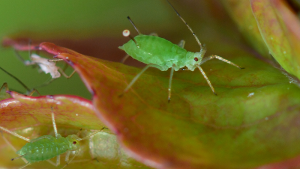
Aphids
Aphids:
Aphids are a huge issue in greenhouses. They often reproduce asexually, allowing them to multiply into large numbers extremely fast. These insects have piercing-sucking mouthparts and use a needle like appendage to pierce into the plant tissue and extract sap from the plant. They tend to target new foliage and flowers, causing malformations from their feeding. These insects can transmit diseases throughout the greenhouse as well as cause mold issues due to the honeydew the excrete. Aphid damage can cause foliage to curl up, creating a barrier that makes them hard to see and control.
Aphids are generally found feeding on the undersides of leaves, new foliage, and sometimes on the bottom parts of plants. Because some of them are wingless and will not get caught on a sticky card, growers should always be on the look out for signs of aphid damage, casings (small white specs that are the exoskeletons after molting), as well as adult individuals.
The key to successful control of aphids is thorough scouting in the greenhouse as well as early action. These insects can easily be controlled by Pyganic Specialty as well as Azera Pro. The contact insecticide in both products will target all life stages of the insect causing paralysis in them which ultimately leads to death. Due to their tendency to spend most of their time in hard to reach places, the azadirachtin systemic mode of action is absorbed into the plant tissue, where it is fed on by hiding aphids. Azadirachtin works as an insect growth regulator and disables the insects’ ability to molt to its next life stage. The chemical also works as an antifeedant. Note: it will take a few days to kill insects exposed only to azadirachtin.
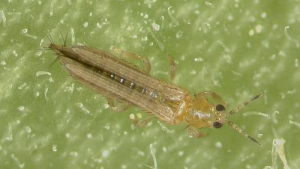
Thrips
Thrips:
Thrips are another major pest greenhouse growers face. Similar to aphids, they are able to reproduce very rapidly causing large infestations to appear seemingly overnight. Thrips have piercing-sucking mouthparts as well and feed in the same way that aphids do. Their feeding causes sunken white patches to form on outer areas of foliage and flowers and can transmit viruses throughout the greenhouse.
Finding thrips can be a little more difficult than finding aphids. They are quite a bit smaller and reside in flowers, on the underside of leaves, and in leaf crevices. Flying thrips will get caught on sticky traps. A grower can also find thrips by knocking a flower on their hand or a white piece of paper and using a hand lens to spot the thrips. Another method is to blow into a flower. The CO2 will make the thrips leave the flower and expose themselves.
Controlling thrips is very similar to the control of aphids. It is based on early identification of the issue and early action. Both Pyganic Specialty and Azera Pro will work on thrips and can be applied via surface spray in any method that is most efficient for the grower’s operation, while ensuring even coverage on the foliage. The mode of action will work identical to how it does for aphids. Applications should be during the early morning or late evening as this is when thrips are most active. Remember that pyrethrins are highly UV sensitive and should not be applied in direct sunlight. The effectiveness of both products is determined by the grower’s ability to thoroughly apply them in the greenhouse.
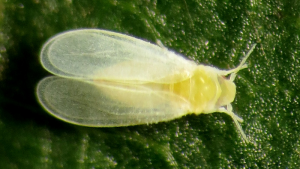
Whitefly
Whiteflies:
Next on the list are whiteflies. While these insects do resemble some flies, they are actually not flies at all and are more closely related to stink bugs, leaf hoppers, and aphids than they are to the common house fly. Just like aphids and thrips, the whiteflies feed with their piercing-sucking mouthparts and spread diseases through the greenhouse. Some species can secrete honeydew. When whiteflies feed, they cause the plants leaves to turn yellow. Sometimes this can be so bad that only the veins in the leaves remain green. In high infestations, whiteflies can cause plants to wilt and ultimately die.
Whiteflies can be found on the underside of leaves and leave behind a white powdery substance. When disturbed, these insects will take flight, making them very easy to spot for growers. They will also get stuck to sticky cards in the greenhouse. The immature whiteflies will remain on the undersides of leaves, as they do not yet have wings.
Whiteflies are best controlled at their immature stage. Because this insect is very mobile as an adult, contact insecticides can become an issue if the insect pressures are very high. Both Azera Pro and Pyganic Specialty will kill whiteflies. It is very important that they are applied thoroughly through the greenhouse. The IGR effect from the azadirachtin in Azera Pro will have affect immatures to a greater extent, as it will not allow them to molt to adulthood.
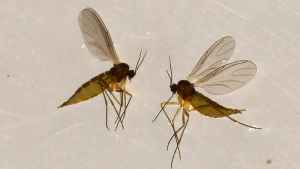
Fungus Gnats
Fungus Gnats:
Another insect pest commonly found in greenhouses are fungus gnats. Fungus gnats are the only insect on this list that do not have piercing-sucking mouthparts. These insects feed primarily as larvae, using their chewing mouthparts, similar to a caterpillar. The immature stages feed on root hairs and plant stems opening passageways for diseases. Their feeding disrupts water and nutrient uptake causing the plant to wilt. The adult fungus gnats do not cause damage by feeding, however, they do transmit fungal spores and other pathogens around the greenhouse.
When scouting for fungus gnats, the adults tend to be easy to find. You can find them resting on the soil surface and flying around the greenhouse if they are disturbed. They can often be mistaken as mosquitos as they resemble them quite a bit. Sticky cards will also work as a detection method for adults. The larvae are a little harder to detect. They can be found burrowed into plant stems and in the upper areas of the soil. Growers can use a piece of a potato placed on the soil or growing media surface as a method to scout for them.
Adult fungus gnats are easily controlled by Pyganic Specialty or Azera Pro. A good thorough spray will get rid of most adults, just make sure the spray is also targeted at the base of plants and the soil surface in containers. Larvae are less likely to be controlled by the Pyganic spray, but can be controlled by the Azera Pro due to the systemic nature of the azadirachtin. Both products are also labeled as a soil drench for control of this insect’s larvae, by applying a sufficient volume of the diluted solution to thoroughly wet the soil, but doesn’t cause significant surface runoff or excessive drip through the pots.
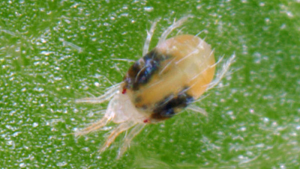
Two-Spotted Spider Mite
Two-Spotted Spider Mites:
Last on this list are the two-spotted spider mites. This is the most common species of mite found in greenhouses, however it should be noted that there can be other species of harmful mites present. Mites are not actually insects, they are more closely related to spiders, scorpions and ticks. Two-spotted spider mites have eight legs and are easily identified due to the two distinctive dots on their abdomen. This can be seen with a hand lens. This mite feeds similarly to aphids, thrips, and whiteflies using their piercing-sucking mouthparts. Severe damage done by their feeding will cause yellowing of the leaves which leads to the leaves falling off the plant. There will also be fine webbing around the area where they are residing, hence the name ‘spider’ mites.
Two-spotted spider mites are generally detected due to the first signs of damage as well as their distinctive webbing that they leave behind. Growers should take extra caution when these mites are present as they can easily be spread via clothing from one plant to the next and all around the greenhouse. They are found on the undersides of leaves and prefer the younger, upper canopy of the plants.
In low infestation levels of two-spotted spider mites, both the Pyganic Specialty and the Azera Pro will be effective. The products will both need thorough coverage of the infested plants. If discovered early on, these products are a great way to control populations. When populations are high, it is generally suggested to get rid of highly infested plants and only treat the plants with low infestation levels. Alternatively, some growers use predatory mites and other beneficial organisms to keep populations low in the greenhouse.*
*Caution: The pyrethrins in both Pyganic Specialty and Azera Pro will kill all beneficial insects in a greenhouse. These products are not intended for use in areas where beneficials are present. They can be used to clean up a greenhouse a couple days prior to beneficials being released as neither products have significant residual qualities.
** Please note that both Pyganic Specialty and Azera Pro have REI intervals of 12 hours.
Article by: Michael Hull
Mycorrhizal Applications – Sales Account Manager and Resident Entomologist
January 15, 2020

